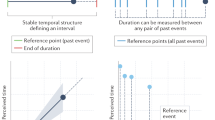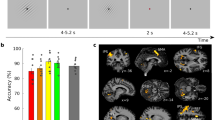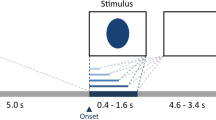Abstract
A large number of competing models exist for how the brain creates a representation of time. However, several human and animal studies point to 'climbing neural activation' as a potential neural mechanism for the representation of duration. Neurophysiological recordings in animals have revealed how climbing neural activation that peaks at the end of a timed interval underlies the processing of duration, and, in humans, climbing neural activity in the insular cortex, which is associated with feeling states of the body and emotions, may be related to the cumulative representation of time.
This is a preview of subscription content, access via your institution
Access options
Subscribe to this journal
Receive 12 print issues and online access
$189.00 per year
only $15.75 per issue
Buy this article
- Purchase on Springer Link
- Instant access to full article PDF
Prices may be subject to local taxes which are calculated during checkout


Similar content being viewed by others
References
Wittmann, M. & Paulus, M. P. Decision making, impulsivity and time perception. Trends Cogn. Sci. 12, 7–12 (2008).
Wittmann, M. & Paulus, M. P. Temporal horizons in decision making. J. Neurosci. Psychol. Econ. 2, 1–11 (2009).
Wittmann, M. & van Wassenhove, V. The experience of time: neural mechanisms and the interplay of emotion, cognition and embodiment. Phil. Trans. R. Soc. B 364, 1809–1813 (2009).
Ivry, R. B. & Schlerf, J. E. Dedicated and intrinsic models of time perception. Trends Cogn. Sci. 12, 273–280 (2008).
Treisman, M. Temporal discrimination and the difference interval: implications for a model of the “internal clock”. Psychol. Monogr. 77, 1–31 (1963).
Gibbon, J., Church, R. M. & Meck, W. H. in Timing and Time Perception. Vol. 423 (eds Gibbon, J. & Allan, L.) 52–77 (New York Academy of Sciences, 1984).
Zakay, D. & Block, R. A. Temporal cognition. Curr. Dir. Psychol. Sci. 6, 12–16 (1997).
Taatgen, N. A., van Rijn, H. & Anderson, J. R. An integrated theory of prospective time interval estimation: the role of cognition, attention and learning. Psychol. Rev. 114, 577–598 (2007).
van Wassenhove, V. Minding time in an amodal representational space. Phil. Trans. R. Soc. B 364, 1815–1830 (2009).
Staddon, J. E. R. Interval timing: memory, not a clock. Trends Cogn. Sci. 9, 312–314 (2005).
Marchetti, G. Studies on time: a proposal on how to get out of circularity. Cogn. Process 10, 7–40 (2009).
Eagleman, D. & Pariyadath, V. Is subjective duration a signature for coding efficiency? Phil. Trans. R. Soc. B 364, 1841–1852 (2009).
Buonomano, D. V. & Maass, W. State-dependent computations: spatiotemporal processing in cortical networks. Nature Rev. Neurosci. 10, 113–125 (2009).
Wackermann, J. & Ehm, W. The dual klepsydra model of internal time representation and time reproduction. J. Theor. Biol. 239, 482–493 (2006).
Buhusi, C. V. & Meck, W. H. What makes us tick? Functional and neural mechanisms of interval timing. Nature Rev. Neurosci. 6, 755–765 (2005).
Bueti, D. & Walsh, V. The parietal cortex and the respresentation of time, space, number and other magnitudes. Phil. Trans. R. Soc. B 364, 1831–1840 (2009).
Ivry, R. B., Spencer, R. M., Zelaznik, H. N. & Diedrichsen, J. The cerebellum and event timing. Ann. NY Acad. Sci. 978, 302–317 (2002).
Lewis, P. A. & Miall, R. C. Remembering the time: a continuous clock. Trends Cogn. Sci. 10, 401–406 (2006).
Craig, A. D. Emotional moments across time: a possible neural basis for time perception in the anterior insula. Phil. Trans. R. Soc. B 364, 1933–1942 (2009).
Lebedev, M. A., O'Doherty, J. E. & Nicolelis, M. A. L. Decoding of temporal intervals from cortical ensemble activity. J. Neurophysiol. 99, 166–186 (2008).
Mita, A., Mushiake, H., Shima, K., Matsuzaka, Y. & Tanji, J. Interval time coding by neurons in the presupplementary motor areas. Nature Neurosci. 12, 502–507 (2009).
Merchant, H., Zarco, W., Pérez, O., Prado, L. & Bartolo, R. Measuring time with different neural chronometers during a synchronization-continuation task. Proc. Natl Acad. Sci. USA 108, 19784–19789 (2011).
Casini, L. & Vidal, F. The SMAs: neural substrate of the temporal accumulator? Front. Integr. Neurosci. 5, 35 (2011).
Pouthas, V. & Perbal, S. Time perception depends on accurate clock mechanisms as well as unimpaired attention and memory processes. Acta Neurobiol. Exp. 64, 367–385 (2004).
Meck, W. Neuropsychology of timing and time perception. Brain Cog. 58, 1–8 (2005).
Lewis, P. A. & Miall, R. C. Distinct systems for automatic and cognitively controlled time measurement: evidence from neuroimaging. Curr. Opin. Neurobiol. 13, 250–255 (2003).
Wiener, M., Turkeltaub, P. & Coslett, H. B. The image of time: a voxel-wise meta-analysis. NeuroImage 49, 1728–1740 (2010).
Koch, G., Oliveri, M. & Caltagirone, C. Neural networks engaged in milliseconds and seconds time processing: evidence from transcranial magnetic stimulation and patients with cortical or subcortical dysfunction. Phil. Trans. R. Soc. B 364, 1907–1918 (2009).
Harrington, D. L. & Haaland, K. Y. Neural underpinnings of temporal processing: a review of focal lesion, pharmacological, and functional imaging research. Rev. Neurosci. 10, 91–116 (1999).
Coslett, H. B., Shenton, J., Dyer, T. & Wiener, M. Cognitive timing: neuropsychology and anatomic basis. Brain Res. 1254, 38–48 (2009).
Coull, J. T., Nazarian, B. & Vidal, F. Timing, storage, and comparison of stimulus duration engage discrete anatomical components of a perceptual timing network. J. Cogn. Neurosci. 20, 2185–2197 (2008).
Buonomano, D. V., Bramen, J. & Khodadadifar, M. Influence of the interstimulus interval on temporal processing and learning: testing the state-dependent network model. Phil. Trans. R. Soc. B 364, 1865–1874 (2009).
Spencer, R. M. C., Karmarkar, U. & Ivry, R. B. Evaluating dedicated and intrinsic models of temporal encoding by varying context. Phil. Trans. R. Soc. B 364, 1853–1864 (2009).
Rammsayer, T. H. Neuropharmacological evidence for different timing mechanisms in humans. Q. J. Exp. Psychol. B 52, 273–286 (1999).
Rammsayer, T. H. Differences in duration discrimination of filled and empty auditory intervals as a function of base duration. Atten. Percept. Psychophys. 72, 1591–1600 (2010).
Fraisse, P. Perception and estimation of time. Ann. Rev. Psychol. 35, 1–36 (1984).
Pöppel, E. A hierarchical model of temporal perception. Trends Cogn. Sci. 1, 56–61 (1997).
Wittmann, M. Moments in time. Front. Integr. Neurosci. 5, 66 (2011).
Nakajima, Y., Shimojo, S. & Sugita, Y. On the perception of two successive sound bursts. Psychol. Res. 41, 335–344 (1980).
Getty, D. J. Discrimination of short temporal intervals: a comparison of two models. Percept. Psychophys. 18, 1–8 (1975).
Ulbrich, P., Churan, J., Fink, M. & Wittmann. M. Temporal reproduction: further evidence for two processes. Acta Psychol. 125, 51–65 (2007).
Lejeune, H. & Wearden, J. H. Vierordt's The Experimental Study Of The Time Sense (1868) and its legacy. Eur. J. Cogn. Psychol. 21, 941–960 (2009).
Noulhiane, M., Pouthas, V. & Samson, S. Is time reproduction sensitive to sensory modalities? Eur. J. Cogn. Psychol. 21, 18–34 (2009).
Morillon, B., Kell, C. A. & Giraud, A. L. Three stages and four neural systems in time estimation. J. Neurosci. 29, 14803–14811 (2009).
Droit-Volet, S. & Gil, S. The time-emotion paradox. Phil. Trans. R. Soc. B 364, 1943–1954 (2009).
Wittmann, M. The inner sense of time. Phil. Trans. R. Soc. B 364, 1955–1967 (2009).
Schirmer, A. How emotions change time. Front. Integr. Neurosci. 5, 58 (2011).
Noulhiane, M., Mella, N., Samson, S., Ragot, R. & Pouthas, V. How emotional auditory stimuli modulate time perception. Emotion 7, 697–704 (2007).
Droit-Volet, S. & Meck, W. H. How emotions colour our perception of time. Trends Cogn. Sci. 11, 504–513 (2007).
Angrilli, A., Cherubini, P., Pavese, A. & Manfredini, S. The influence of affective factors on time perception. Percept. Psychophys. 59, 972–982 (1997).
Effron, D. A., Niedenthal, P. M., Gil, S. & Droit-Volet, S. Embodied temporal perception of emotion. Emotion 6, 1–9 (2006).
Falk, J. L. & Bindra, D. Judgment of time as a function of serial position and stress. J. Exp. Psychol. 47, 279–282 (1954).
Watts, F. N. & Sharrock, R. Fear and time estimation. Percept. Mot. Skills 59, 597–598 (1984).
Wearden, J. H. & Penton-Voak, I. S. Feeling the heat: body temperature and the rate of subjective time, revisited. Q. J. Exp. Psychol. B 48, 129–141 (1995).
Somov, P. G. Time perception as a measure of pain intensity and pain type. J. Back Muscoloskelet. Rehabil. 14, 111–121 (2000).
Craig, A. D. How do you feel — now? The anterior insula and human awareness. Nature Rev. Neurosci. 10, 59–70 (2009).
Wittmann, M., Simmons, A. N., Aron, J. & Paulus, M. P. Accumulation of neural activity in the posterior insula encodes the passage of time. Neuropsychologia 48, 3110–3120 (2010).
Wittmann, M. et al. Neural substrates of time perception and impulsivity. Brain Res. 1406, 43–58 (2011).
Kosillo, P. & Smith, A. T. The role of the human anterior insular cortex in time processing Brain Struct. Funct. 214, 623–628 (2010).
Meissner, K. & Wittmann, M. Body signals, cardiac awareness, and the perception of time. Biol. Psychol. 86, 289–297 (2011).
Sysoeva, O. V., Wittmann, M. & Wackermann, J. Neural representation of temporal duration: coherent findings obtained with the 'lossy integration' model. Front. Integr. Neurosci. 5, 37 (2011).
Pollatos, O., Herbert, B. M., Kaufmann, C., Auer, D. P. & Schandry, R. Interoceptive awareness, anxiety and cardiovascular reactivity to isometric exercise. Int. J. Psychophysiol. 65, 167–173 (2007).
Coull, J. T. & Nobre, A. C. Dissociating explicit timing from temporal expectation with fMRI. Curr. Opin. Neurobiol. 18, 137–144 (2008).
Jin, D. Z., Fujii, N. & Graybiel, A. M. Neural representation of time in cortico-basal ganglia circuits. Proc. Natl Acad. Sci. USA 106, 19156–19161 (2009).
Matell, M. S., Shea-Brown, E., Gooch, C., Wilson, A. G. & Rinzel, J. A heterogeneous population code for elapsed time in rat medial agranular cortex. Behav. Neurosci. 125, 54–73 (2011).
Niki, H. & Watanabe, M. Prefrontal and cingulate unit activity during timing behavior in the monkey. Brain Res. 171, 213–224 (1979).
Leon, M. I. & Shadlen, M. N. Representation of time by neurons in the posterior parietal cortex of the macaque. Neuron 38, 317–327 (2003).
Janssen, P. & Shadlen, M. N. A representation of the hazard rate of elapsed time in macaque are LIP. Nature Neurosci. 8, 234–241 (2005).
Kalenscher, T., Ohmann, T., Windmann, S., Freund, N. & Güntürkün, O. Single forebrain neurons represent interval timing and reward amount during response scheduling. Eur. J. Neurosci. 24, 2923–2931 (2006).
Renoult, L., Roux, S. & Riehle, A. Time is a rubberhand: neural activity in monkey motor cortex in relation to time estimation. Eur. J. Neurosci. 23, 3098–3108 (2006).
Durstewitz, D. Self-organizing neural integrator predicts interval times through climbing activity. J. Neurosci. 23, 5342–5353 (2003).
Reutimann, J., Yakovlev, V., Fusi, S. & Senn, W. Climbing neural activity as an event-based cortical representation of time. J. Neurosci. 23, 3295–3303 (2004).
Simen, P., Balci, F., deSouza, L. Cohen, J. D. & Holmes, P. A model of internal timing by neural integration. J. Neurosci. 31, 9238–9253 (2011).
Pfeuty, M., Ragot, R. & Pouthas, V. Relationship between CNV and timing of an upcoming event. Neurosci. Lett. 382, 106–111 (2005).
Praamstra, P. in Attention and Time (eds Nobre, A. C., Coull, J. T.) 331–344 (Oxford Univ. Press, 2010).
Kononowicz, T. W. & Van Rijn, H. Slow potentials in time estimation: the role of temporal accumulation and habituation. Front. Integr. Neurosci. 5, 48 (2011).
Van Rijn, H., Kononowicz, T. W., Meck, W. H., Ng, K. K. & Penney, T. B. A critical evaluation of the theoretical interpretations of the contingent negative variation and its relation to time estimation. Front. Integr. Neurosci. 5, 91 (2011).
Cui, X., Stetson, C., Montague, P. R. & Eagleman, D. M. Ready...go: amplitude of the fMRI signal encodes expectation of cue arrival time. PLoS Biol. 7, e1000167 (2009).
Wang, X. J. Decision making in recurrent neuronal circuits. Neuron 60, 215–234 (2008).
Heekeren, H. R., Marrett, S. & Ungerleider, L. G. The neural systems that mediate human perceptual decision making. Nature Rev. Neurosci. 9, 467–479 (2008).
Rammsayer, T. Effects of pharmacological induced dopamine-receptor stimulation on human temporal information processing. Neuroquantology 7, 103–113 (2009).
Coull, J. T., Cheng, R.-K. & Meck, W. H. Neuroanatomical and neurochemical substrates of timing. Neuropsychopharmacology 36, 3–25 (2011).
Wiener, M., Lohoff, F. W. & Coslett, H. B. Double dissociation of dopamine genes and timing in humans. J. Cogn. Neurosci. 23, 2811–2821 (2011).
Reuter, M. et al. The influence of the dopaminergic system on cognitive functioning: a molecular genetic approach. Behav. Brain Res. 164, 93–99 (2005).
Wittmann, M. et al. Effects of psilocybin on time perception and temporal control of behaviour in humans. J. Psychopharmacol. 21, 50–64 (2007).
Wackermann, J., Wittmann, M., Hasler, F. & Vollenweider, F. X. Effects of varied doses of psilocybin on time interval reproduction in human subjects. Neurosci. Lett. 435, 51–55 (2008).
Sysoeva, O. V., Tonevitsky, A. & Wackermann, J. Genetic determinants of time perception mediated by the serotonergic system. PLoS ONE 5, e12650 (2010).
Craig, A. D. How do you feel? Interoception: the sense of the physiological condition of the body. Nature Rev. Neurosci. 3, 655–666 (2002).
Critchley, H. D., Wiens, S., Rotshtein, P., Öhman, A. & Dolan, R. J. Neural systems supporting interoceptive awareness. Nature Neurosci. 7, 189–195 (2004).
Singer, T., Critchley, H. D. & Preuschoff, K. A common role of insula in feelings, empathy and uncertainty. Trends Cogn. Sci. 13, 334–340 (2009).
Picard, F. & Craig, A. D. Ecstatic epileptic seizures: a potential window on the neural basis of self-awareness. Epilepsy Behav. 16, 539–546 (2009).
Wackermann, J. in Multidisciplinary Aspects of Time and Time Perception (eds Vatakis, A., Esposito, A., Giagkou, M., Cummins, F. & Papadelis, G.) 246–257 (Springer, 2011).
Wackermann, J. & Späti, J. Asymmetry of the discrimination function for temporal durations in human subjects. Acta Neurobiol. Exp. 66, 245–254 (2006).
Acknowledgements
The author is grateful to J. Wackermann and K. Meissner for comments on earlier versions of the manuscript and wishes to thank the three anonymous reviewers whose criticism and suggestions helped to improve the final version of the paper. Over the years, the author's research has been supported by the Bundesministerium für Bildung und Forschung (Bonn/Berlin), the Else-Kröner-Fresenius Foundation (Bad Homburg), the Max Kade Foundation (New York), the National Institute on Drug Abuse (Bethesda) and the Kavli Institute for Brain and Mind (San Diego). The author has also been supported by the European project COST ISCH Action TD0904 “Time In MEntaL activitY: theoretical, behavioral, bioimaging and clinical perspectives” (TIMELY).
Author information
Authors and Affiliations
Ethics declarations
Competing interests
The author declares no competing financial interests.
Related links
Rights and permissions
About this article
Cite this article
Wittmann, M. The inner sense of time: how the brain creates a representation of duration. Nat Rev Neurosci 14, 217–223 (2013). https://doi.org/10.1038/nrn3452
Published:
Issue Date:
DOI: https://doi.org/10.1038/nrn3452
This article is cited by
-
The role of depressive symptoms in the interplay between aging and temporal processing
Scientific Reports (2023)
-
A common timing mechanism across different millisecond domains: evidence from perceptual and motor tasks
Scientific Reports (2023)
-
Ants’ capability of associating odors with time periods of the day
Journal of Ethology (2023)
-
Developmental trajectory of time perception from childhood to adolescence
Current Psychology (2023)
-
Time in schizophrenia: a link between psychopathology, psychophysics and technology
Translational Psychiatry (2022)



